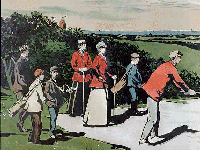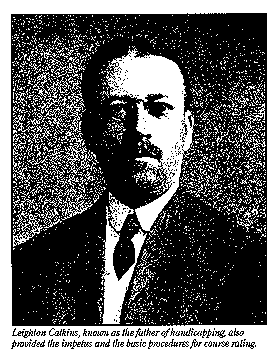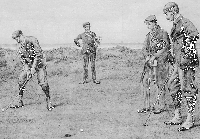|
THE EARLY HISTORY OF HANDICAPPING PART TWO: In which we expore the concept of par, the theory of course rating, and meet the father of American Handicapping.
by Dean Knuth
Handicapping, among its other benefits, allows men and women to have fair matches regardless of each player's golf skills.

WHERE DID par come from? It was probably derived from a stock market term: "A stock may be above or below its proper, normal, or par figure." Its first reference was apparently in the British magazine Golf; in 1870. A writer named A. H. Doleman asked Davie Strath and Jamie Anderson, two professionals, what score would be required to win The Belt at the then-12-hole course at Prestwick; their response was that perfect play should produce a score of 49. Mr. Doleman called this "par" for Prestwick. Young Tom Morris scored two strokes over par for three rounds (36 holes) to win The Belt, and the term stuck.
He also suggested, in an article dated January 28, 1898: "Base par on how the scratch players as a mass of first-class players score on the courses." A rule of thumb, published in 1898, was that the course par should be six strokes less than the bogey. (Note: Prior to par, bogey was the standard based upon the score of a first-class player.)
Another British writer commented on Doleman's suggestion in the same year "The par of the green, according to his [Doleman's] conception, as we understand it, is something very like a glorified 'Bogey' score-the ideal to which a first-class golfer may aspire without fluking, yet without a fault. Mr. Doleman arrives at his par score by calculating the length of the holes according to the driving powers of a first-class player, and adds two for the approach putt and the holing out on each green. Thus a hole that can be reached in one will be put down as a par 3. The present method of determining the relative difficulty of courses is to compare the scores in which first-class players accomplish them (higher than par)."
A Governing Body?
The concept caught the golfing public's attention. A letter, published on October 28, 1898, in a British newspaper, called for a governing body to regulate course ratings: "In the absence of any authoritative legislation on the subject, most golf clubs have made Bogey laws (course ratings) for themselves. The net result is hopeless confusion, and it seems time that some attempt was made to indicate the lines on which the laws for Bogey should be laid down."
The golf community was quick to respond. Three key figures were Dr. Laidlaw Purves and Mr. Henry Lamb, members of the Royal Wimbledon Golf Club, and Miss Issette Pearson, of the Ladies Golf Union (LGU). According to Clapcott's The History of Handicapping, compiled for the English Golf Union in 1936, "Dr. Laidlaw Purves set out the rules for universal handicapping (1898) which were evolved at Wimbledon. These rules indeed may be regarded as the basis upon which the British Golf Union's Joint Advisory Council have built up their system of uniform handicapping (average of the best three scores over two years of medal scores)."
And Issette Pearson was instrumental in developing an early form of uniform course rating; she assigned the first ratings to member clubs of the LGU.
Robert Browning, in A History of Golf, says of the LGU, "Their biggest achievement was the gradual establishment of a national system of handicapping .... No doubt it was uphill work at the start (1893), but within eight or ten years the LGU had done what the men had signally failed to do-established a system of handicapping that was reasonably reliable from club to club."
The First USA Handicap System
Activity in the United States brought about the next step in the U.K At a USGA Executive Committee meeting on February 8, 1896, Dr. E. C. Rushmore, club champion at Tuxedo Golf Club, appealed to the USGA to appoint an official handicapper. Mr. John Reid, of St. Andrews Golf Club, in Yonkers, New York, disagreed and no action was taken.

Leighton Calkins, later president of Plainfield Country Club, in New Jersey, proposed in 1905 to the Metropolitan Golf Association the British system of averaging the best three scores. It was adopted, and he was quickly appointed Handicap Chairman of the MGA. Another prominent golf association of the period, the Massachusetts Golf Association, quickly adopted the formula, but insisted that bogey be the scratch standard; Calkins had argued for a par standard, which was adopted by the Metropolitan Golf Association.
At a meeting on October 11, 1911, at the Baltusrol Golf Club, the USGA adopted a modified form of Calkins's system, the first USGA Handicap System. A year later, the USGA created the first national USGA Handicap list for use at the 324 USGA member clubs, naming those golfers who were eligible to enter the U.S. Amateur Championship, which at the time required a 6 handicap or better. The USGA also accepted Calkins's proposal that par ratings be based on the standard of ability of the U.S. Amateur champion, Jerome Cravers. Rating courses according to the "expected" score of the national amateur champion became accepted, and Course Rating was born in America. Calkins was angered, however, by the USGA's decision to allow clubs to determine their own ratings, calling such a system "a farce" and "useless."
Calkins later made his point; official USGA Course Ratings were issued for the USGA by regional golf associations, just as they are today.
By 1914, the USGA rating concept began to dominate articles in the British golf magazines. A rating procedure was developed in both countries by 1925, and a Joint Advisory Committee of the British Isles was formed to assign Standard Scratch Scores to golf courses, just as USGA Course Ratings were issued by golf associations to courses in the United States. Today, the men's authority is called the Council of National Golf Unions (CONGU).

If this putt fails to fall, will the player elect to take his bisque on this hole? What's a bisque, you ask? See the text for an explanation.
Bisques
An early history of handicapping would be incomplete without mention of a form of match-play handicapping now nearly extinct, the "bisque. " The player who receives strokes in a match today gets the full difference in his handicap from the lower-handicap player who plays at scratch. The strokes are allocated to holes in the order they are ranked on the score card or allocation table. To play with bisques, the player receiving strokes receives normally only half the difference in handicaps (or as negotiated at the first tee). Instead of receiving them on preassigned holes, the player may use his bisques at any time that he chooses, even after a hole has been finished. The use of a bisque then might turn a lost hole into a half, or a half into a win, a procedure that certainly adds strategy and gamesmanship to a match.
But the receiver must be careful with his bisques. If he uses them too late, he can lose the match before playing the crucial finishing holes. Bisques are applied only to singles matches and four-somes golf; they do not work in four-ball matches.
|






